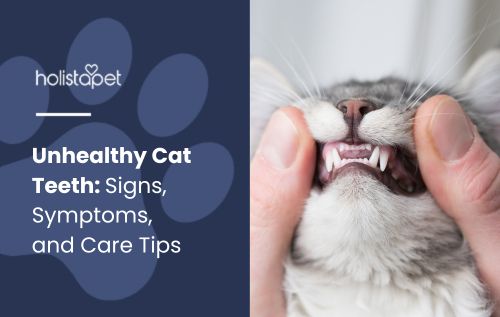Ever find yourself asking, "Why is my cat scared of everything?" Many pet owners deal with timid cats, and it can be frustrating to see their pet so fearful of just about anything.
Understanding your cat's fears and addressing their anxious behaviors is the first step in creating a more relaxed and happy environment for your furry friend. Let's explore what's behind this issue and how you can help!
Recognizing Fearful Behavior in Cats

Fearful demeanor in cats is more common than you think. Felines can be naturally shy and develop frightened behaviors due to various factors. Knowing what to look for is key to understanding and addressing their worries so you can help them feel confident and safe again.
Common Signs That Your Cat Is Scared of Everything
Spooked behavior in felines can manifest in different ways, so it's important to know what to look for. Be ready to take action if your cat shows signs like:
- Hiding. Your shy cat may retreat to hiding spots when they feel stressed or terrified.
- Trembling. Shaking or trembling is a common reaction to fear.
- Cat Litter Box Issues. Fear can cause your pet to avoid their litter box or make accidents outside of it.
- Aggressive Behavior. A scared cat may act out aggressively to defend themselves.
- Sudden Movements. Your kitty may flinch or dart away at quick movements or loud sounds.
- Dilated Pupils: When cats are frightened, their pupils may dilate significantly as part of their fight-or-flight response.
- Vocalizing: Cats may yowl, hiss, or growl as a reaction to fear or anxiety.
- Ears Flattening: When scared, a cat may flatten their ears against their head to show distress or discomfort.
- Hunched Posture: A fearful cat may crouch low to the ground, trying to make themselves appear smaller or more protected.
- Excessive Grooming: Cats sometimes groom excessively when they feel anxious as a self-soothing mechanism.
- Avoiding Eye Contact: Cats that are scared often avoid direct eye contact as a way of signaling submission or anxiety.
Understanding the Causes of Fear in Cats
Several factors could be influencing your skittish cat's behavior. Understanding the root causes is essential in helping your kitty overcome anxiety and feel more secure in their environment. Let's break it down and consider what might be driving your cat's worries.
Early Life Experiences and Their Impact on Fearful Behavior
If your cat had a rough start in life, it could explain why they're so terrified. Being separated too early from their mother or exposure to traumatic events can leave lasting emotional scars. These experiences shape how they respond to new people, environments, or situations.
Traumatized felines might be more hesitant or frightened in unfamiliar settings because of their unpleasant experiences. A calm and patient approach can help rebuild trust with your dear pet.
Genetics and Temperament: Why Some Cats Are More Anxious
Some cats are naturally more anxious than others due to their genetics. Certain breeds or individual felines may be more prone to fear and anxiety. A skittish kitty might just be born that way!
For these pets, loud noises or sudden movements may cause them to react more intensely than other cats. Understanding that some level of fear may be inherent can help you better manage your kitty's worries with patience and care.
Environmental Factors That Contribute to Fear in Cats
Cats are sensitive to their surroundings, and an overwhelming space can cause them to feel afraid. Here are some common environmental factors that could contribute to a fearful cat:
- New Furniture. Changes in your home, like changing or rearranging furniture, can unsettle your pet.
- Other Pets. Introducing a new pet can stress your cat out, especially if they're not used to other animals.
- Loud Noises. Thunderstorms, fireworks, or even loud music can trigger fear.
- New People. New family members or guests might make your kitty feel anxious.
Related Post: Why Is My Cat Scared of Me? Overcoming Fear in Cats
Medical Conditions That May Cause Fear in Cats
If your cat's behavior seems out of the ordinary, visiting your vet could help identify potential causes. Conditions like hormonal imbalances or vision problems can make your feline friend feel vulnerable, increasing their fear. Let's take a look at some medical reasons that might be behind your pet's fearful demeanor.
Hormonal Imbalances and Fearful Behavior
Hormonal imbalances can make felines feel out of control or overly sensitive. For example, cats in heat or those with thyroid issues may act more scared or agitated than usual.
If your cat's fearfulness seems linked to hormonal changes, it's worth discussing with your vet. Hormonal treatments or adjustments may help reduce your cherished companion's anxiety.
Vision and Hearing Problems That Can Contribute to Anxiety
If your cat struggles to see or hear clearly, they might react with heightened fear to things they can't properly perceive. Quick movements or loud sounds could especially startle them.
Talk to your trusted veterinarian if you suspect your pet has vision or hearing issues. Addressing these problems can help your kitty feel more safe and secure.
Can CBD Benefit Fearful Cats?
Many pet owners have found that CBD (cannabidiol) products can help promote relaxation and reduce distress in their cats. CBD works by interacting with the body's endocannabinoid system (ECS), which helps regulate mood, stress levels, and more.
CBD may help your feline friend feel more at ease in challenging situations by providing a soothing effect. But as always, consult with your vet before introducing any new products to your kitty's routine.
HolistaPet CBD Products That Support a Calm, Happy Cat

HolistaPet offers a range of CBD products designed specifically for cats to support a calm, stress-free life. From our CBD Cat Treats and Calming Soft Chews to our CBD Oils and Capsules, our products help your kitty feel more at ease during moments of fear and anxiety.
Check out our CBD cat products on our website. They may just be the calming solution your furry friend needs!
How To Create a Safe Environment for a Fearful Cat
Creating a safe space for your fearful cat is key to helping them feel more secure. Here are a few steps you can take:
- Have a quiet room where your kitty can relax away from the chaos of your home.
- Provide hiding spots where your cat can hide and rest.
- Keep introductions to new things short and sweet to avoid overwhelming your pet.
- Try not to change your cat's routine as much as possible to make them feel secure.
Setting up a Calm, Quiet Space for Your Cat
Setting up a calm space where your cat can retreat and relax is essential to reducing their anxiety. Keep the area free from loud noises, quick movements, and new people.
Make sure the room has everything your cat needs: food, a litter box, and cozy hiding spots. Doing so will give your kitty a safe place to escape whenever they feel overwhelmed.
How To Introduce New Experiences and People Gradually
Gradual introductions help prevent overwhelming your cat, giving them time to adjust to changes at their own pace. Whether it's a new person, pet, or experience, take small steps to make sure your feline companion doesn't feel threatened.
Start by allowing your cat to observe from a distance before bringing them closer. Positive reinforcement, like offering treats and praise, can also help create a positive association with new experiences.
Training Techniques To Help a Fearful Cat Overcome Anxiety
Training techniques like desensitization and positive reinforcement can help your feline friend overcome their fear. Here's how they work in a nutshell:
- Desensitization. Gradually expose your cat to their fear triggers in a controlled way.
- Positive Reinforcement. Reward them with treats and praise for good behavior during stressful situations.
These methods allow your pet to build confidence and reduce their anxiety. With patience and consistency, you can help your furry buddy feel more secure in their space.
Desensitization and Counter-Conditioning for Fearful Cats
Slowly exposing your cat to the things that scare them in a controlled and positive way can help them build tolerance. This approach involves pairing a feared stimulus with something your pet enjoys to create a positive association. Over time, your kitty may become less sensitive to their fear triggers and learn to remain calm.
Positive Reinforcement Strategies To Build Confidence
Rewarding your furry friend for calm behavior during stressful situations encourages them to repeat those positive actions. Treats, praise, and petting can go a long way in boosting their self-esteem.
Consistency is key! Reward your cat every time they display brave behavior, even if it's a small step toward overcoming their fear.
The Role of Diet and Supplements in Managing Fearful Behavior

Nutritional support can be a game-changer for felines dealing with anxiety. A well-balanced diet, combined with certain supplements, can support your pet's mental health and reduce anxious habits.
Certain vitamins, minerals, and fatty acids can help soothe anxiety, while CBD and other calming supplements may provide additional support. Keep an eye on what your cat is eating to make sure they're getting the nutrients they need to feel safe and secure.
How Proper Nutrition Can Support Your Cat's Mental Health
Proper nutrition supports your cat's overall well-being, including their mental health. A balanced diet rich in essential nutrients can help reduce anxiety and improve their emotional state. Make sure your cat's food contains high-quality protein, healthy fats, and essential vitamins to aid their brain function.
Consider adding supplements, like omega-3 fatty acids, which can promote calmness and help manage anxious behaviors. A healthy diet can give your kitty the boost they need to feel more relaxed and confident.
When To Seek Professional Help for Your Fearful Cat
If your cat's anxiety is severe or persistent, it might be time to seek professional help. A veterinarian or veterinary behaviorist can assess your feline companion's behavior and offer expert advice or treatment options.
Don't hesitate to consult a professional if your cat's fear is affecting their quality of life. With the right support, you can help your pet overcome their fears and live happier, calmer days.
Recognizing When a Vet or Behaviorist Is Needed
If your cat's fearful demeanor is extreme or worsening, reach out to a vet or behaviorist. Signs that you should seek help include:
- Severe Aggression. Your cat becomes overly aggressive in response to stress, often hissing, scratching, or biting without provocation.
- Constant Hiding. They seek refuge in hiding spots for long periods and avoid interacting with you or their surroundings.
- Complete Inability To Cope With Daily Activities. Your pet struggles with basic activities like eating, using the litter box, or socializing.
Early intervention is key to helping your kitty overcome their fears. A professional can help identify underlying issues and suggest effective treatment options.
Long-Term Solutions for Managing Fearful Behavior in Cats
Managing your cat's skittish behavior is a long-term commitment. With the right strategies, you can help them become more relaxed and confident. Consider these tips:
- Consistent Training. Regularly rewarding good behavior helps build your cat's confidence over time.
- Calm Surroundings. Creating a serene space free from loud noises, sudden movements, and stressors supports your pet's emotional well-being.
- Proper Nutrition. Providing a balanced diet with essential nutrients and calming supplements can help reduce anxiety.
Patience and consistency are important as you work to build your kitty's confidence. With time, you'll notice improvements in their behavior, helping them feel more at ease in their surroundings.
How To Maintain Progress and Prevent Setbacks
To continue making progress with your fearful cat, provide ongoing attention and care. Regularly reinforcing positive behavior and continuing your established calm routines will help your kitty stay confident. It's also important to avoid pushing them too hard; sudden changes can lead to setbacks.
Be mindful of any new stressors that may arise, and be ready to adjust your approach if needed. Consistency in training and creating a stable environment will help prevent regression and keep your feline friend moving toward a calmer, happier state.
Helping your pet conquer their fears is totally possible with the right approach! By understanding their triggers, creating a relaxed environment, and staying consistent with training, your furry friend will feel more confident and relaxed, stat. Don't forget that patience is key. With some love and effort, your scaredy-cat can become a brave, happy kitty!







![Probiotics For Dogs [Soft Chews] - HolistaPet](http://www.holistapet.com/cdn/shop/files/Probiotic-Infographic-1_472d7a29-e30c-435a-9638-1365d8c3a9f9.jpg?v=1725384841&width=104)



























Leave a comment
All comments are moderated before being published.
This site is protected by hCaptcha and the hCaptcha Privacy Policy and Terms of Service apply.